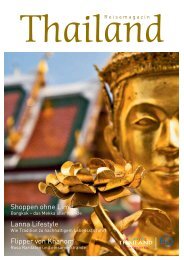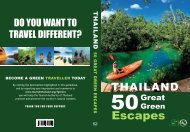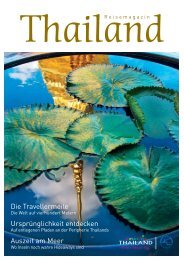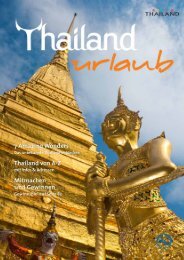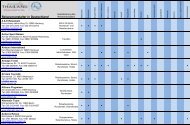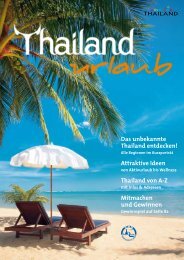Chiang Rai
Chiang Rai
Chiang Rai
Create successful ePaper yourself
Turn your PDF publications into a flip-book with our unique Google optimized e-Paper software.
Chok Jamroean Tea Plantationon Doi Mae Salong<strong>Chiang</strong> <strong>Rai</strong>Phayao • Phrae • Nan
Phu Chi Fa Forest ParkContents<strong>Chiang</strong> <strong>Rai</strong> 8Phayao 20Phrae 26Nan 32
8Wat Phrathat Doi Tung<strong>Chiang</strong> <strong>Rai</strong><strong>Chiang</strong> <strong>Rai</strong> is a small, charming city thatprovides the perfect base for exploring thescenic and cultural attractions of Thailand’s farnorth.Doi Tung Palace
8 9Located 785 kilometres north of Bangkok, <strong>Chiang</strong> <strong>Rai</strong> is thecapital of Thailand’s northernmost province. At an averageelevation of nearly 600 metres above sea level and covering anarea of approximately 11,700 square kilometres, the provinceborders Myanmar to the north, and Lao PDR to the north andnortheast. The area is largely mountainous, with peaks rising to1,500 metres above sea level, and flowing between the hillranges are several rivers, the most important being the Kok,near which the city of <strong>Chiang</strong> <strong>Rai</strong> is situated. In the far north ofthe province is the area known as the Golden Triangle, wherethe Mekong and Ruak Rivers meet to form the borders ofThailand, Myanmar and Lao PDR Inhabiting the highlands arehilltribes like the Akha, Lahu, Karen, and Hmong.The region boasts a long history with small kingdoms datingback to the pre-Thai period, while the city of <strong>Chiang</strong> <strong>Rai</strong> wasfounded in 1262 by King Mengrai. It was temporarily thecapital of Mengrai’s Lanna Kingdom until being superseded by<strong>Chiang</strong> Mai. Today, <strong>Chiang</strong> <strong>Rai</strong> is a small, charming city thatprovides the perfect base for exploring the scenic and culturalattractions of Thailand’s far north.City AttractionsKing Mengrai MonumentCommemorating the founder of <strong>Chiang</strong> <strong>Rai</strong>, the monumentshould be the first place to visit, since locals believe that respectshould be paid to King Mengrai before travelling further. Themonument is located on the city outskirts beside the road toMae Chan.Wat Phra Sing
10 11The King Mengrai StupaIn front of Wat Ngam Mueang atop Doi Ngam Mueang inMueang district the stupa was built by King Chaisongkhram tocontain the remains of his father (King Mengrai).Wat Phra SingThis temple, on Singhakhlai Road, is a fine example of Lannareligious architecture. The Phra Phuttha Sihing image, now at<strong>Chiang</strong> Mai’s Wat Phra Sing, was originally enshrined here.A copy now sits in its place.Wat Phra KaeoLocated behind Wat Phra Sing, Wat Phra Kaeo is noted for itslate Lanna image hall and several fine bronze Buddha images.The temple is more famous, however, as the place where thestatue of the Emerald Buddha, now housed in Bangkok, wasoriginally discovered.Wat Phrathat Doi Chom ThongThis ancient hilltop temple predates the founding of <strong>Chiang</strong> <strong>Rai</strong>and commands fine views of the Kok River. It is believed thatfrom this vantage point King Mengrai first surveyed the site ofthe city. Situated on a small hill west of Wat Phra Kaeo, thetemple has an ancient brick chedi that is the reliquary for theremains of King Mengrai.Oub Kham MuseumIt’s located near the Den Ha market, 1 kilometre from thecentre of town. The collection showcases objects from the areasonce belonging to, or affiliated with, the Lanna kingdoms:present north Thailand and some parts of northeast Myanmar,southwest China and Vietnam. Apart from ritual objects thecollection mainly consists of objects used in royal courts likelacquerware, silver jewellery, and clothing. A golden bowlonce reserved for royals is a masterpiece. It is open dailyfrom 9 a.m. - 6 p.m. Tel: 0 5371 3349Ho Watthanatham NithatThe site is a museum exhibiting ancient artefacts and writtenrecords on history, literature and local know-how as well asexhibits on royal activities by the late Princess Mother at DoiTung. It is open to the public Wednesday - Sunday from 8.30a.m. until 3.30 p.m.Kok RiverThis scenic river is a major transportation artery fromneighbouring <strong>Chiang</strong> Mai province, especially the town of ThaTon. The river runs some 130 kilometres through the heart of<strong>Chiang</strong> <strong>Rai</strong> passing on its way several hilltribe settlements andWat Phra Kaeoelephant camps from where jungle treks start. Long-tailed boatsare available daily for 3-4 hour tours.Namtok Khun Kon Forest ParkKhun Kon, also known as Tat Mok Waterfall, is located about30 kilometres south of <strong>Chiang</strong> <strong>Rai</strong>. The 70-metre waterfall isthe highest and most beautiful in <strong>Chiang</strong> <strong>Rai</strong>.Out-Of-City AttractionsAmphoe Mae ChanHot SpaLocated 8 kilometres from Mae Chan, along the Mae Chan -Mae Ai Road, this complex has hot mineral water and bath -house facilities. Accommodation is also available.Hilltribe Development and Welfare CentreThe centre, located some 15 kilometres along Doi Mae SalongRoad, aids and administers local hilltribe settlements. Hilltribehandicrafts, including woven cloth and silverware, are availablefor purchase.
12 13Thoet Thai-Ban Huai In route which winds along a steepprecipice. The inhabitants are predominantly of the Lisu tribe,with a smattering of Akha, Hmong and Muser. Doi Hua MaeKham is most scenic in November when the yellow WildSunflowers are in full bloom.Amphoe Mae SaiMae SaiThis border town is the northernmost point of Thailand, facingMyanmar across the Mae Sai River, and is located 61 kilometresnorth of <strong>Chiang</strong> <strong>Rai</strong> on Highway 110. The town presents greatshopping opportunities for buying popular Thai, Burmese andChinese goods.Doi Mae SalongAmphoe Mae Fa LuangDoi Mae SalongLocated some 40 kilometres beyond Mae Chan, the ruggedmountain of Doi Mae Salong is topped by a settlement knownas Santi Khiri, home to descendants of Chinese Nationalistsoldiers who settled in the area in the 1940s. The mountainsideplantations of coffee and fruit orchards provide scenic variety,especially picturesque in December and January when Thaicherry trees are in blossom. Hotels, restaurants, horse-riding andtrekking are among the major attractions.Doi TungThis northernmost mountain offers several attractions, includingDoi Tung Royal Villa, built for the late Princess Mother anddesigned in an architectural combination of Lanna and Swisschalet styles; the Mae Fa Luang Botanical Garden, withcolourful plants and trees of many different species within rock,aqua, palm and flower gardens, and various hilltribe villages.The mountain is topped by the revered temple of Wat PhrathatDoi Tung, which contains Buddha relics and also commands aspectacular panoramic view of the surrounding countryside.Khun Nam Nang NonThe name translates as “ lagoon of the sleeping lady” and isderived from a natural rock formation that resembles a recliningwoman. It is located 12 kilometres before reaching the town ofMae Sai along a 2-kilometre spur road.Tham Pum-Tham Pla (Reed & Fish Caverns)Located 1 kilometre north of Khun Nam Nang Non, these cavesare known for their spectacular interiors.Tham Pha ChomThis cave, 2.5 kilometres west of Mae Sai, is noted for itsbeautiful stalactites and as a place for meditation.Amphoe <strong>Chiang</strong> Saen<strong>Chiang</strong> SaenThe town of <strong>Chiang</strong> Saen, delightfully situated on the banks ofthe Mekong River, is the site of an ancient settlement thatpredates <strong>Chiang</strong> <strong>Rai</strong> and survives in the ruins of city walls,moats, gateways and temples.Doi Hua Mae KhamPha Mi Akha VillageThis picturesque hilltribe village is one of the most accessibleAkha settlements in <strong>Chiang</strong> <strong>Rai</strong> province, located on the way tothe summit of Doi Tung.Doi Hua Mae KhamThe site is the domicile of the hilltribe near the Thai-Burmeseborder, about three hours by road along the Mae Chan-Ban
14 15The Golden TriangleThe Golden TriangleEight kilometres north of <strong>Chiang</strong> Saen, this famous riversidespot marks where the borders of Thailand, Lao PDR andMyanmar meet at the junction of the Mekong River and thesmall Ruak tributary. Boats on the Mekong can be hired fortravel upstream from <strong>Chiang</strong> Saen to the Golden Triangle, ordownstream to <strong>Chiang</strong> Khong.<strong>Chiang</strong> Saen National MuseumThis small museum is dedicated to the historical settlement of<strong>Chiang</strong> Saen and its ancient culture, and provides informationon archaeological sites and ethnic minorities in the MekongRiver basin, as well as displaying exhibits of Buddha imagesand Lanna artefacts. The museum is open from Wednesday toSunday from 9.00 a.m. to 4.00 p.m. except official holidays.Wat Phrathat Chedi LuangWat Phrathat Chedi Luang, built in 1291, is the biggest ancientpagoda in <strong>Chiang</strong> <strong>Rai</strong> province, comprising a 58-metre high,brick bell-shaped chedi with an octagonal base. The main halland other surrounding chedis are in ruins.Wat Pa SakWat Phrathat Chom KittiThis hilltop temple, reached by a flight of 339 steps, has a chedienshrining the Lord Buddha relic.Wat Phrathat Pha NgaoThis small bell-shaped pagoda built on top of a hill, 4kilometres along the <strong>Chiang</strong> Saen-<strong>Chiang</strong> Khong road,commands a spectacular view over the Mekong River andLao PDR beyond. The temple houses a magnificent<strong>Chiang</strong> Saen-style Buddha image.Wat Phrathat Doi Pu KhaoThis riverside temple, near the Sop Ruak Market, offersan amazing panorama over the Golden Triangle andthe surrounding mountains.Wat Phrathat Pha NgaoWat Pa SakWat Pa Sak occupies a 16-acre site just outside the city walls,200 metres from the Tourist Service Centre. The chedi, builtin 1295, is decorated with ornamental stucco motifs and isregarded as one of the most beautiful examples of Lannaarchitecture in northern Thailand.
16 17Phu Chi Fa Forest ParkWat Phra Chao Lan ThongThe temple is located within the city wall, built by Prince ThongNgua, a son of King Tilokkarat, the 12 th ruler of Lanna, in 1489.A 1,200-kilogramme Buddha statue was cast. Named Phra ChaoLan Thong, it has a lap width of 2 metres and is over 3 metreshigh. Another statue called Phra Chao Thong Thip was also castin brass and in the Sukhothai style.<strong>Chiang</strong> Saen LakeSouth of <strong>Chiang</strong> Saen, along Highway 1016 (two kilometresfrom the Km. 27 marker) this scenic 640-acre lake hostsmigratory flocks of waterfowl during the winter months.Accommodation and water-sport facilities are available.Amphoe <strong>Chiang</strong> Khong<strong>Chiang</strong> KhongLocated 55 kilometres east of <strong>Chiang</strong> Saen and 114 kilometresnortheast of <strong>Chiang</strong> <strong>Rai</strong> town, this pleasant traditional settlementfaces Lao PDR across the Mekong River.Ban Hat KlaiThis is the area where pla buek, or giant freshwater catfish,weighing up to 300 kg. are caught in the Mekong from April toJune.Ban Hat BaiThis Thai Lue community, located 25 kilometres along the<strong>Chiang</strong> Saen-<strong>Chiang</strong> Khong road, is noted for its hand-wovencotton.Doi Pha TangAmphoe ThoengPhu Chi Fa Forest ParkThis mountain, some 25 kilometres south of Doi Pha Tang, ischaracterised by high, steep cliffs providing a panoramic viewover Lao PDR. Its highest peak points out sharply towards thesky. Mist commonly shrouds the mountaintop in the earlymorning, especially in the cool season. During February, whitewild flowers, known as dok siao, dot the area.Amphoe Wiang KaenDoi Pha TangSome 32 kilometres from Amphoe Wiang Kaen (127 kilometresfrom <strong>Chiang</strong> <strong>Rai</strong> town), this scenic 1,638-metre mountain ishome to Hmong and Yao ethnic minorities, and affords fineviews of the Thai-Lao border. During December and January,the area is rendered even more picturesque with cherryblossoms and, in the morning, mountain mists.Amphoe PhanDoi Luang National ParkThis park, some 65 kilometres south of <strong>Chiang</strong> <strong>Rai</strong> town, coversan area of 1,170 square kilometres and extends into parts of<strong>Chiang</strong> Mai, Lampang and Phayao provinces. The park’s majorattraction is the Pu Kaeng Waterfall.Namtok Pu KaengThis waterfall is in Doi Luang National Park located in Phandistrict. To get there, drive down the <strong>Chiang</strong> <strong>Rai</strong>-Phayao routefor 58 kilometres to arrive at Bang Pu Kaeng. At Km.77 takea right turn and drive on for another 9 kilometres to a large
18 19waterfall amid virgin jungle with water cascading downlimestone brooks. There are camping areas and jungle trekkingservices.Amphoe Wiang Pa PaoWiang KalongThis community located about 16 kilometres from the districtoffice of Wiang Pa Pao. Here they found remains of ancientfurnaces used to make terracotta utensils. The furnaces areshaped likes turtle shells of various sizes with a width of 2 to 5metres.Mae Khachan Hot SpringsThe hot springs located at Tambon Mae Chedi Mai on the<strong>Chiang</strong> <strong>Rai</strong> - <strong>Chiang</strong> Mai road at Kms. 64 - 65, next to a stream.Villagers sell eggs to tourists to boil in the hot springs.Khun Chae National ParkAt Tambon Mae Chedi Mai of Wiang Pa Pao district, the parkcan be reached by taking the <strong>Chiang</strong> Mai-<strong>Chiang</strong> <strong>Rai</strong> route(Highway No. 118). The park headquarters is right next to thehighway at Kms. 55-56 Visitors wishing to undertake a jungletrek and camp within the park need to have the services of aguide and prepare their own camping equipment. The trekthrough the Khun Chae jungle is for adventure travel enthusiastsas the route passes over steep terrain and several hilltops andcliffs over 1,400 metres high. There are good viewpoints andtrekkers can enjoy waterfalls, flowing streams and virgin jungleareas lush with plant life.Special EventsWai-sa Phaya MengraiEnd of January or early February held to commemorate KingMengrai as the founder of <strong>Chiang</strong> <strong>Rai</strong> and the Lanna Kingdom,the festival features parades, cultural performances and variouscompetitions.Songkran and <strong>Chiang</strong> Saen Boat Races13-15 April, Songkran, the traditional Thai New Year, is wellcelebrated at <strong>Chiang</strong> Saen, where boat races between teamsfrom Thailand, Lao PDR, China and Myanmar are held on theMekong River. Cultural shows and beauty contests to crown theQueen of the Golden Triangle are other attractions.Lychee FairHeld the third weekend in May, the fair celebrates <strong>Chiang</strong> <strong>Rai</strong>’stastiest fruit, and also features various agricultural displays andexhibitions, local handicrafts, folk dancing and beauty contests.Cotton Wearing at Ban Si Don Chai VillageShopping<strong>Chiang</strong> <strong>Rai</strong> is rich in handicrafts such as handwoven cotton,hilltribe silver ornaments and woodcarvings. Agriculturalproducts include lychee (in season April-May), pineapples andtea, as well as temperate climes produce from various royalprojects.How To Get ThereBy AirThai Airways International operates daily flights from Bangkokto <strong>Chiang</strong> <strong>Rai</strong>.Tel. 0 2628 2000, 0 2280 0060 or Hotline 1566www.thaiairways.comBy BusThe 10-hour journey from Bangkok can be made by eitherairconditioned or non-airconditioned bus, leaving from theBangkok Bus Terminal on Kamphaeng Phet II Road.Tel. 0 2936 2852-66www.transport.co.thBy CarFrom Bangkok, take Highway 1 then Highway 32 to NakhonSawan and then Highway 1 again to <strong>Chiang</strong> <strong>Rai</strong> via Phayao,Lampang and Tak, a total distance of 785 km.
20 21A small, peaceful province of mostly hills and valleys, Phayaocovers an area of 6,335 square kilometres and lies about 690kilometres north of Bangkok. It is also conveniently accessibleby road from <strong>Chiang</strong> Mai and <strong>Chiang</strong> <strong>Rai</strong>. Phayao was formerlyruled by its own kings, one of whom, King Ngam Mueang, isbelieved to have assisted his close friend, King Mengrai, inestablishing <strong>Chiang</strong> Mai as the new capital of Lanna in the late13 th century. As with other northern principalities, the mostvisible reminders of regal connections are the Buddhist templeseither built or patronised by former rulers. The modernprovincial capital of Phayao is set beside an attractive mountain-fringedlake on the banks of which are located severalinteresting sights. Accommodation and other facilities aremodest, but offer simple comforts.City AttractionsKwan PhayaoThis is the largest freshwater lake in the upper North, and itsstocks of fish provide a livelihood for many of the local people.The surrounding scenery, particularly at sunset, is stunning.Along the shores of the lake are food shops and recreation areas.Wat Si Khom KhamThe temple, located on the shore of Kwan Phayao, enshrines thelargest Lanna style Buddha image, the seated statue measuring16 metres high and 14 metres across the lap. It is said that ittook 33 years to complete. Celebrations are held here every yearin May.Phra Chao Ton Luang, Wat Si Khom KhamPhayaoThe modern provincial capital of Phayao is setbeside an attractive mountain-fringed lake onthe banks of which are located several interestingsights. Accommodation and other facilitiesare modest, but offer simple comforts.Kwan Phayao
22 23<strong>Chiang</strong> KhamThe district, about 74 kilometres northeast of Phayao town onHighway 1021, is home to many Thai Lue people whoseancestors migrated from Yunnan, in southern China, some 200years ago. Also interesting is Wat Nantaram, a Burmese-styletemple constructed from teak.Wat NantaramAn interesting temple in <strong>Chiang</strong> Kham is Wat Nantaram, aBurmese-style site built entirely with teak. The woodwork onthe windows, gables, corridors and other parts are beautifullychiseled in elaborate designs.Phra Nang DinHo Watthanatham NithatSituated next to Wat Si Khom Kham, this folk museum housesexhibits relating to the history, native culture and traditions ofPhayao.Wat Phrathat Chom ThongOpposite Wat Si Khom Kham and reached by a 1.5-kilometreuphill road, this attractively sited temple offers panoramic viewsof the lake and Phayao town.Namtok Phu SangNamtok Phu Sang is a scenic waterfall about 20 kilometres tothe north of the district town of <strong>Chiang</strong> Kham on Highway No.1093. The surroundings are still in perfect natural condition.Phu Sang is different than other waterfalls. It is fed by a hotspring on the mountain which flows into the brook beforecascading over the rocks.Namtok Phu SangFresh-water Fishery StationLocated in town on Highway 1, this is the first facility in theworld to successfully breed the giant pla buek catfish. There isan aquarium displaying many species of fish and water plants.Pho Khun Ngam Mueang MemorialSituated in a park beside Kwan Phayao, the memorial commemoratesthe 13 th century ruler of Phu Kam Yao, duringwhose reign the state prospered and expanded its territory. PhuKam Yao is also famous for the alliance of harmony, loyalty andnon-aggression that Pho Khun Ngam Mueang forged with KingMengrai of <strong>Chiang</strong> Mai and King Ramkhamhaeng of Sukhothai.Out-Of-City AttractionsWat AnalayoThe hilltop temple of Wat Analayo, set in an extensive treeshadedarea about 7 kilometres north of town and a further 9kilometres along a turn to the left, is noted for its collection ofreligious-based sculptures by contemporary artists.
24 25How To Get ThereBy AirTravellers can take a flight from Bangkok to <strong>Chiang</strong> <strong>Rai</strong>, thentake a bus which leaves <strong>Chiang</strong> <strong>Rai</strong> Bus Terminal for a 1.15-hour journey to Phayao.Thai Airways International operates daily flights from Bangkokto <strong>Chiang</strong> <strong>Rai</strong>.Tel. 0 2628 2000, 0 2280 0060 or Hotline 1566www.thaiairways.comBy BusBoth airconditioned and non-airconditioned buses depart fromBangkok Bus Terminal on Kamphaeng Phet II Road to Phayaodaily. Travel time is about 9 hours.Tel. 0 2936 2852-66www.transport.co.thSongkran Festival, <strong>Chiang</strong> KhamBy CarFrom Bangkok, take Highway 1 then Highway 32 to NakhonSawan and then Highway 1 again to Phayao via Lampang andTak, a total distance of 690 km.Namtok Champa ThongA high waterfall in a beautiful natural setting, Champa Thong isreached by turnoff at Km. 7 along the Phayao-<strong>Chiang</strong> <strong>Rai</strong> road.Doi Phu Nang National ParkThis national park is 48 kilometres south of Amphoe DokKhamtai along Highway No. 1251 and 4 kilometres along anaccess road. A variety of birds flock here, especially peacockswhich come to the park area for breeding from January toMarch. The park also has a scenic waterfall called Namtok ThanSawan. Camping in the park is possible.Thai Lue People, <strong>Chiang</strong> KhamBan Tham Indigenous Cultural CentreLocated about 15 kilometres from the district town of DokKhamtai on the way to <strong>Chiang</strong> Muan district, the centre has alarge collection of agricultural implements, as well as ancientartefacts.ShoppingProducts made from woven water hyacinth fibres are aspeciality of Ban San Pa Muang, about 15 kilometres fromPhayao town on the way to Wat Analayo. In <strong>Chiang</strong> Kham,hand-woven cotton is a traditional handicraft of the Thai Lue.
26 27Covering an area of 6,538 square kilometres and with itsprovincial capital located 551 kilometres north of Bangkok,Phrae is surrounded on all sides by mountains, with level plainsin the middle. It is noted for having one of the largest reservesof teak forests in the country. The province has a remote feelabout it, although it is easily reached by Highway 101. Phraetown, situated on the Yom River, is an old community, foundedslightly after <strong>Chiang</strong> Mai, and retains much of its traditionalcharacter, with quiet streets and a number of old teak houses.Cultural influences blend Lanna, Burmese and Lao styles.Principal interests are both cultural and scenic.City AttractionsWat LuangMost likely dating from the founding of Phrae, Wat Luang is avenerable temple of considerable interest, especially in its large<strong>Chiang</strong> Saen-style chedi, its image hall and a museum housingseveral antique Buddha images.Wat Phra NonLocated west of Wat Luang, near the site of the old city walls,Wat Phra Non dates back some 300 years and enshrines a 9-metre-long image of the reclining Buddha. The temple buildingsare excellent examples of Lanna architecture, with impressiveroofs and fretted eaves.Wat Phra Bat Ming MueangLocated on Charoen Nakhon Road, near the townhall, Wat PhraBat Ming Mueang was built in 1955 by combining two ancientWat Phrathat Cho HaePhraePhrae town, situated on the Yom River, is anold community, founded slightly after <strong>Chiang</strong>Mai, and retains much of its traditional character,with quiet streets and a number of old teakhouses.Wat Chom Sawan
28 29Wat Sa Bo Kaeotemples. There is an old chedi containing a replica of theBuddha’s footprint.The City Pillar ShrineSituated on Khun Doem Road in the town centre, the city pillarshrine features an inscription from the Sukhothai perioddescribing the building of a temple in the town.Wat Chom SawanOne kilometre from the town hall, on Yantrakit Koson Road,Wat Chom Sawan is an even more impressive Burmese-styletemple, characterised by multi-tiered roofs, fine fretwork andelaborately decorated interiors. Antique Buddha imagesenshrined here include a marble statue and another made fromwoven bamboo covered in lacquer.Wat Sa Bo KaeoLocated on Nam Khu Road, next to the city moat, this temple isdistinguished by its Burmese-style architectural features.Out-Of-City AttractionsWat Phrathat Cho HaeThis major religious site is located about 8 kilometres east oftown along Highway 1022. The Sukhothai-period temple isfamous for its 33-metre-high <strong>Chiang</strong> Saen-style chedi, built ofbricks and covered with bright brass sheets. The name refers toa fine silk cloth woven in Xishuangbanna (in China’s Yunnanprovince), which was used to wrap around the chedi when theWat Phrathat Chom Chaengtemple was first constructed. Enshrined in the temple is therevered Buddha image of Phra Chao Than Chai.Wat Phrathat Chom ChaengStanding 3 kilometres from Wat Phrathat Cho Hae, this temple,built in 788, has a 29-metre-tall golden chedi, which enshrines aholy relic. There is also a museum of rare ancient relics.Ban Thung HongAbout 4 kilometres from town along Highway 101 is BanThung Hong, a village noted for the making of products,especially farmers’ shirts, from mo hom, a local cotton fabricdyed a distinctive blue colour.Phae Mueang Phi Forest ParkLocated 12 kilometres out of town along Highway 101 and afurther 6 kilometres after a right turn, Phae Mueang Phi literallymeans “Ghost Land”, the name derived from the weirdgeological phenomenon found here. The area is treeless, andsubsidence and erosion have created a landscape of strange rockand soil formations in the shape of pillars and what look likeexotic mushrooms.Ban Fai Folklore MuseumSituated in the same compound as Ban Fai garden restaurant, 3kilometres from town on the Phrae-Sung Men Road, themuseum comprises several wooden buildings with exhibitsexemplifying local lifestyles, shophouses and a traditionalmarket.
30 31Koeng Noi is 2 kilometres further. Streams from the falls flowinto the Yom River.Mae Yom National ParkLocated in Song district, 48 kilometres from town, Mae YomNational Park covers mountainous terrain, where teak forestsare probably the densest in the country. Along the Yom River, infront of the camping site, is a 2-kilometre stretch of rapids, bestvisited during November-February when the weather is cool andthe scenery at its loveliest.Phae Mueang Phi Forest ParkHua Dong MarketAbout 9 kilometres south of town on Highway 101, HuaDong Market is a centre for furniture and home decorativeitems made from wood and rattan.Wat Phra LuangAbout 700 metres off Highway 101 at Ban Hua Dong is WatPhra Luang, featuring a Sukhothai-period chedi, knownlocally as “ That Noeng” or “ leaning chedi”.Fabric Weaving VillageLong district, some 45 kilometres from the provincial townon Highway No. 1023, is the site of a centuries-old community.The local people are skilled in the craft of weaving, bothsilk and cotton. The art of making the tin chok fabric, inparticular, has been handed down from generation togeneration. Its design has been developed to appeal tomodern tastes, although the original method has beenretained. A fair celebrating the fabric is held annually in theLong district around November.Wiang Kosai National ParkThe Wiang Kosai National Park is about 70 kilometres fromthe provincial town in Wang Chin district. It can be reachedby taking Highway No. 11 (Phrae-Lampang). Then take aleft turn toward Wang Chin district and continue for a further13 kilometres to reach the turn to the park headquarters. Afurther 1.5 kilometres on are two waterfalls, the Mae KoengLuang, one kilometre from the headquarters, while the MaeSpecial EventsPhrathat Cho Hae FairThis temple fair features a Lanna-style procession in which thepeople, dressed in traditional costume, carry robes with whichto cover the temple’s chedi.Kin Salak FairHeld in September, this is an old Buddhist merit-makingcelebration in which villagers prepare offerings and carry themin a procession to present to monks.ShoppingPhrae is well known for two fabrics of high quality: mo hom,made mainly in Ban Thung Hong and using traditional methodsof weaving, dying and tailoring, and tin chok, a fine materialwith a distinctive design used for handbags, shoes and householddecorative items, as well as clothing. The main productioncentres are Long, Wang Chin and Den Chai districts.How To Get ThereBy <strong>Rai</strong>lTrains leave from Bangkok <strong>Rai</strong>lway Station to Den Chaidistrict daily, then travellers can take a mini-bus to Phrae.Tel. 0 2220 4334 or Hotline 1690www.railway.co.thBy BusBoth airconditioned and non-airconditioned buses depart fromBangkok Bus Terminal on Kamphaeng Phet II Road to Phraedaily.Tel. 0 2936 2852-66www.transport.co.thBy CarFrom Bangkok, take Highway 1 then Highway 32 to NakhonSawan, then Highway 117 to Phitsanulok and then turn right toHighway 11 to Phrae, a total distance of 550 km.
32 33Extending over an area of 11,472 square kilometres, and with itsprovincial capital located 668 kilometres north of Bangkok, Nanis a remote province, yet one that is richly rewarding in both itscultural and scenic attractions. The town of Nan nestles in theverdant valley of the river of the same name, surrounded bydensely forested hills, and was formerly an independent citystate back in the 13 th century. During its long history, Nan wasinitially influenced culturally and politically by Sukhothai,before coming under the influence of first the Lanna Kingdom,centred in <strong>Chiang</strong> Mai, and later the Burmese. With theexpulsion of the Burmese in the 18 th century, Nan continued toenjoy a semblance of independence until coming under the fullcontrol of Bangkok in the early 1900s.Evidence of such a rich past is still present in a number ofhistoric temples, while the scenic attractions of the surroundingcountryside, home to numerous Thai Lue and other hilltribepeoples, add another dimension to touring the region.City AttractionsNan National MuseumHoused in what was formerly the residence of the ruler of Nan,the museum is an excellent starting point for a tour of the town,its displays highlighting the region’s history and the evolutionof the arts.Wat Phrathat Chae HaengPerhaps the most impressive of Nan’s venerable temples, WatPhrathat Chae Haeng lies about 2 kilometres from town onWat PhuminNanNan is a remote province, yet one that isrichly rewarding in both its cultural andscenic attractions. The town of Nan nestles in theverdant valley of the river of the same name,surrounded by densely forested hills, and wasformerly an independent city state back in the13 th century.Wat Phrathat Chae Haeng
36 37Tham Pha Tup Forest ParkLying some 10 kilometres north of Nan town, this a complex of17 caves in what is part of a new wildlife reserve.Doi Phu Kha National Parkdistrict some 25 kilometres en route to Bo Kluea district lies theDoi Phu Kha National Park . The terrain is mainly forested landson limestone mountain ranges, the source of several streamswhich merge into the Nan River. The elevation is about 1,900metres above sea level and it is home to near-extinct flora,particularly the Chomphu Phu Kha (bretschneidera ninesishemsl.), whose pink flowers are in full bloom during February.In the morning, a sea of mist can be seen drifting across thevalley. There are also several scenic waterfalls. Permits to campcan be obtained. Alternatively, tourists may choose to utilise theaccommodation services in the park.Si Nan National ParkThe Si Nan National Park covers extensive forested andmountainous areas. Pha Chu is the major attraction in the park.The cliff can be reached by taking the Nan-Wiang Sa - Na Noiroute for 135 kilometres, then turning into Highway No. 1083and on for another 22 kilometres. The cliff top offers anexcellent viewing point to enjoy a panoramic vista of themountains. A national flag pole has a lanyard running all theway down to the foot of the hill, the longest in the country.There are camping areas for visitors in the park.Hom ChomThis is a natural geological phenomenon of earthen pillarsformed by soil erosion, similar to Phae Mueang Phi in Phrae. Itis located about 10 kilometres from Na Noi district on Highway1083.Rafting on the Wa RiverThis exciting activity waits for tourists who like to shoot manyrapids. Rafting can be accompanied by elephant riding. Thesuitable time for rafting is from September to February. Visitorscan contact travel agencies in the town.Special EventTraditional Long Boat RacesHeld in October or November, these are among the largest andarguably the most exciting of all the traditional longboatregattas held by many riverine communities around Thailand tocelebrate the end of Buddhist Lent.ShoppingTextilesNan is noted for its quality hand-woven textiles in variouspatterns, the most famous being lai nam lai, “ flowing waterdesign”, which depicts stepped patterns representing streamsand waterfalls.HandicraftsSilverware, woodcarving and hilltribe handicrafts are popularsouvenirs.Musical InstrumentsNan is also known for its musical instruments, in particular thesalo, a violin-like instrument, and the sueng, similar to a guitar.How To Get ThereBy AirPB Air operates flights from Bangkok to Nan on Monday,Wednesday, Friday and Sunday.Tel. 0 2261 0220, 0 5422 6238www.pbair.comBy BusThe 9-hour journey from Bangkok to Nan can be made by eitherairconditioned or non-airconditioned bus, leaving from theBangkok Bus Terminal on Kamphaeng Phet II Road.Tel. 0 2936 2852-66www.transport.co.thBy CarFrom Phrae, Nan is readily accessible by Highway 101, a shortdistance of 118 km.




